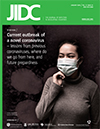Evaluation of cardiovascular risk factors in people living with HIV in São Paulo, Brazil
DOI:
https://doi.org/10.3855/jidc.11326Keywords:
HIV, Cardiovascular Disease, Risk FactorAbstract
Introduction: HIV infection as a chronic disease has emerged from treatment advances over the past three decades. From this perspective, the diseases associated with AIDS are not a main threat for patients who use Antiretroviral Therapy (ART). A new set of HIV associated complications have emerged resulting in comorbidities related to aging and ART exposure as cardiovascular disease (CVD). This study aimed to evaluate the cardiovascular risk factors in people living with HIV (PLWH) in Brazil.
Methodology: This was a cross-sectional study carried out at all Specialized Care Services for people living with HIV in the Southeast of Brazil. A sociodemographic and clinical questionnaire was used and cardiovascular risk assessed through the Framingham Score. Data analysis was performed by Chi-square, Fisher’s exact test and logistic regression.
Results: The majority were male, over 40 years old and they showed a mean age of 44 years. Current hypertension, diabetes, altered body mass index, presence of metabolic syndrome and altered abdominal circumference were also associated with cardiovascular risk. After regression analysis, male sex, older age, smoking, diabetes, hypertension and metabolic syndrome were related as predictive factors for a higher cardiovascular risk.
Conclusions: The results demonstrate that combination of the prevention of modifiable risk factors with considerable changes in lifestyle are determining factors for success in the therapeutic of PLWH. High levels of motivation are essential for behavioral changes, and nurses are ideally position to provide safe care with nonpharmacological strategies for CVD risk reduction.
Downloads
Published
How to Cite
Issue
Section
License
Authors who publish with this journal agree to the following terms:
- Authors retain copyright and grant the journal right of first publication with the work simultaneously licensed under a Creative Commons Attribution License that allows others to share the work with an acknowledgement of the work's authorship and initial publication in this journal.
- Authors are able to enter into separate, additional contractual arrangements for the non-exclusive distribution of the journal's published version of the work (e.g., post it to an institutional repository or publish it in a book), with an acknowledgement of its initial publication in this journal.
- Authors are permitted and encouraged to post their work online (e.g., in institutional repositories or on their website) prior to and during the submission process, as it can lead to productive exchanges, as well as earlier and greater citation of published work (See The Effect of Open Access).








